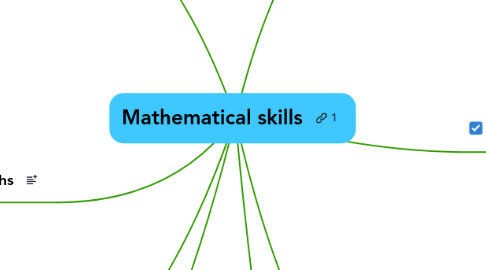
1. Trigonometry
1.1. angular measure
1.1.1. radians
1.1.2. degrees
1.1.3. mills
1.2. evaluate trigonometric functions
1.3. definitions of sin, cos and tan
1.4. basic trigonometric identities
1.4.1. Pythogorous identity
1.4.2. tangent
1.5. addition formula - multiple angles
1.6. double angle formulae
1.7. Worded problems
1.7.1. sketching appropriate figures
1.7.2. application of sin, cos or tan
1.7.3. angle of elevation and depression
1.8. sine and cosine rules
1.9. Northings and Eastings
1.10. Approximations for small angles
1.11. Series representation
1.12. Changing Cartesian to Polar co-ordinates
1.12.1. Use of R->P and P->R on calculator
1.13. Compound angles
1.13.1. sin(A+B) = ...
1.13.2. cos(A+B) = ...
1.13.3. tan(A+B) = ...
2. Functions and Graphs
2.1. linear relationships
2.2. polynomials
2.3. exponentials
2.3.1. y=exp(ax); a>0
2.3.2. y=exp(-ax); a>0
2.3.3. y=exp(-a(x-c)^2)
2.3.4. distinguish exponentials
2.3.5. Re-write exponentials
2.3.6. population models
2.3.7. Sketch and interpret
2.4. logarithms
2.4.1. Definition - ln vs log
2.4.2. solve for x: y = n^x
2.4.3. quadratics
2.4.4. effect of doubling the arguments of log
2.5. trigonometric
2.5.1. trigonometric ratios of acute angles
2.5.2. trigonometric ratios of large angles
2.5.3. Basic trig identities
2.5.4. Graphs of ...
2.5.4.1. y = sin(x)
2.5.4.2. y=cos(x)
2.5.4.3. y=cos(x+a)
2.5.4.4. y=cos(x/2+a)
2.5.4.5. y=sin(2x)
2.5.4.6. y=cos(2x)
2.5.4.7. y=sin(x+a)
2.5.4.8. y=sin(x/2+a)
2.5.4.9. y=tan(x)
2.5.4.10. y=tan(2x)
2.5.4.11. y=tan(x/2)
2.5.5. Periodicity of trig functions
2.5.6. Sinusoidal form - A sin( omega t +/- alpha)
2.5.7. Solution of trig equations
2.5.7.1. Using inverse functions in the calculator
2.5.7.2. in the interval [0, 360]
2.5.7.2.1. sin(x) = a
2.5.7.2.2. sin(2x+c) = a
2.5.7.2.3. sin(x/2+c) = a
2.5.7.2.4. cos(x) = a
2.5.7.2.5. cos(2x+c) = a
2.5.7.2.6. cos(x/2+c) = a
2.5.7.2.7. tan(x) = a
3. Vectors
3.1. vector addition
3.2. resolution of vectors
3.3. vector subtraction
3.4. Products
3.4.1. scalar or dot product
3.4.2. cross product
4. Matrices
4.1. addition, subtraction
4.2. product of matrices
4.3. determinant of a matrix
4.4. inverse of a matrix
4.5. eigenvalues
4.6. eigenvectors
5. Arithmetic
5.1. Order of evaluation - BODMAS
5.2. Fractions
5.3. Numbers
5.3.1. natural
5.3.2. integers
5.3.3. rational
5.3.4. irrational
5.3.5. transcendental
5.3.6. algebraic numbers
5.3.7. in other bases
5.3.7.1. binary
5.3.7.2. octal
5.3.7.3. hexa decimal
5.4. Scientific notation
5.5. Decimals
5.6. Percentages
5.7. Ratios and proportions
5.8. SI Units
5.9. Arithmetic using mixed scales
5.10. Binary arithmetic
5.11. Use of calculator
5.11.1. Entering negative numbers
5.11.2. Entering exponents - 1.5E-4
5.11.3. Inverse trigonometric
5.11.4. Powers of negative numbers - (-2)^3
6. Algebra
6.1. indices
6.1.1. apply rules of indices
6.1.1.1. positive integral exponents
6.1.1.2. negative exponents
6.1.1.3. fractional powers
6.1.2. square root notation
6.1.3. meaning of a^0
6.2. solution of equations
6.2.1. linear equations
6.2.1.1. a x + b = c
6.2.1.2. a/bx = c/d
6.2.1.3. cross multiply
6.2.1.4. a/(b+x) = c/(d + x)
6.2.2. simultaneous equations
6.2.2.1. algebraic method
6.2.2.2. graphical method
6.2.2.3. elimination method
6.2.3. quadratic equation
6.2.3.1. by factorization
6.2.3.2. graphical method
6.2.3.3. using the formula
6.2.4. polynomial equations
6.2.4.1. simple cubic; x^3 = a
6.2.4.2. simple quartic; x^3 = a
6.2.4.3. equations leading to simple cubic or quartic
6.3. non-linear equations
6.3.1. polynomial
6.3.2. trigonometric
6.3.3. exponential
6.3.4. logarithmic
6.4. Transformation of formulae
6.4.1. adding or subtracting the same
6.4.2. multiplying both sides
6.4.3. reciprocating both sides
6.4.4. taking square roots both sides
6.4.5. raising both sides to a fractional power
6.4.6. exponentiate both sides
6.4.7. taking logs on both sides
6.4.8. apply a function to both sides
6.5. Inequalities
6.5.1. sketch intervals
6.5.1.1. abs(x+a) = b
6.5.1.2. Untitled
6.5.1.3. Untitled
6.6. Evaluation of formulae
6.6.1. simple formulae
6.6.2. formulae with mixed units and mixed scales
6.7. Direct and inverse proportions
6.8. Algebraic Manipulation
6.8.1. expand brackets - mixed signs
6.8.2. factorization
6.8.3. polynomial division
6.8.3.1. long division
6.8.4. algebraic fractions
6.8.4.1. Combine into a single fraction
6.8.4.2. Re-arrange and simplify
6.8.4.3. Distinguish A/(x-2) vs A/x-2
6.8.4.4. Mixed algebraic - number algebraic fraction
6.8.4.5. Mixed algebraic - fraction + algebraic
6.8.4.6. Monomial plus algebraic fraction
6.8.4.7. Divide the fraction into individual terms
6.8.4.8. Monomials plus fractions with additional coefficients
6.8.5. Remainder theorem
6.9. Partial Fractions
6.9.1. Linear factors
6.9.2. Repeated factors
6.9.3. Linear and quadratic factors
6.9.4. Improper fraction - requiring long division
7. Calculus
7.1. Differentiation
7.1.1. concept of instantaneous rate of change
7.1.2. derivatives of polynomials
7.1.3. use of table look up for sin(ax), cos(ax), exp(ax), log(ax)
7.1.4. stationary values
7.1.5. inflexion points
7.1.6. second derivatives
7.1.7. determine the shape of the curve given the derivatives
7.1.8. determine maxima, minima
7.1.9. simple applications (limited to functions not involving chain rule, product rule or quotient rule)
7.1.10. application of product, quotient and chain rules
7.2. Integration
7.2.1. opposite of differentiation
7.2.2. constant of integration
7.2.3. Integrals of polynomials - y = ax^n + ...
7.2.4. table look up - x^n, sin(ax), cos(ax), exp(ax), ln(ax)
7.2.5. algebraic substitutions
7.2.6. trigonometric substitutions
7.2.6.1. t = tan(theta/2) substitution
7.2.7. change of limits
7.2.8. using partial fractions
7.2.9. Integration by parts
7.2.10. Applications
7.2.10.1. area under the curve y = f(x), between x=a and x = b
7.2.10.2. area bounded between the two curves y = f(x), and y = g(x)
7.2.10.3. volumes of solids of revolution
7.2.10.4. centroids of simple shapes
7.2.10.5. mean and root mean square values
7.2.10.6. second moments of area
7.2.11. Numerical integration
7.2.11.1. Trapezoidal rule
7.2.11.2. Simpson's rule
7.2.11.3. Advanced techniques - Gaussian, adaptive
8. Differential equations
8.1. First order equations
8.1.1. Analytical techniques
8.1.1.1. Integrating factor
8.1.1.2. seperation of variables
8.1.1.3. Laplace transform techniques
8.1.2. Initail value problem
8.1.3. Numerical methods
8.1.3.1. Euler's method
8.1.3.2. Modified Euler's method
8.1.3.3. Adam-Moulton method
8.1.3.4. Runge-Kutta methods
8.1.3.5. Adam-Bashforth method
8.2. Second order equations
8.2.1. Analytical techniques
8.2.1.1. Characteristic equation
8.2.1.2. Power series method
8.2.2. Initial Value Problem
8.2.3. Boundary Value Problem
8.2.4. Numerical methods
